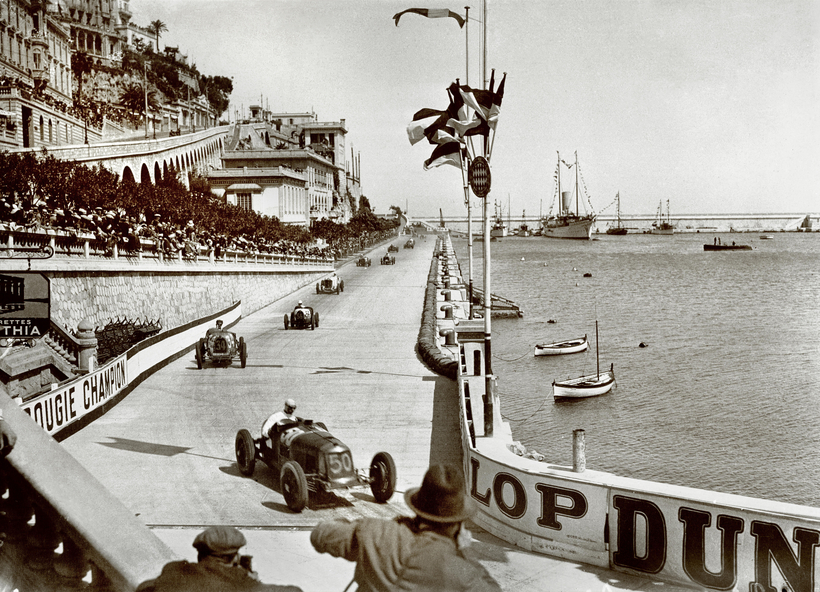I love Jews, like cars, and hate Nazis. But I didn’t know the first used the second to beat the third in a Grand Prix race in 1938, just as the world was careening toward war. Neal Bascomb’s Faster tells the zippy story of how it happened, the eccentrics who pulled it off, the machines they built to do it, and the gory roads they took to get there.
One of the pleasures of this book is that it has the best collection of proper nouns I’ve ever seen. Tazio “the Maestro” Nuvolari wins a motorcycle race with two broken legs, Louis “the Old Fox” Chiron woos the wives of tycoons, Count Carlo Felice Trossi smokes a pipe and owns a castle, Stanislaw Czaykowski gets buried with his charred Bugatti steering wheel, and Alice “Baby” Hoffmann leaves a pharmaceutical heir for a driver, and then another. Anatol is her pet monkey.
But the story belongs to the Jewish race-car driver René Dreyfus, a wiry and worried man whose hair starts turning gray by age 30. Even when he’s gripping his wheel and gazing deeply into a camera’s lens, the driver has the air of a substitute teacher.
Crash and Dash
Dreyfus takes to speed in boyhood, coaxing his siblings into his two-seater pedal car, driving them down the town’s biggest hill, and flipping over. His older brother pukes, but René’s just getting started. At one of his first races, the 1926 La Turbie climb through the French Alps, his brother rides along as his onboard mechanic—it’s not that Dreyfus needs the help, but the more responsible sibling knows the little speed freak will be less inclined to tumble down the cliffs if both of their lives are at stake.

Dreyfus teams up with Lucy O’Reilly Schell, a rich, short, loud, and brave woman with bobbed auburn hair and a sturdy husband named Laury. The couple races in the 1932 Monte Carlo Rally, starting 2,300 miles away in Sweden and speeding through blizzards and across black ice, an experience that one journalist riding in the back compares to “being stuck inside a cocktail shaker.” Driving isn’t Schell’s true calling: she starts her own race team, putting Dreyfus behind the wheel of a car called the Delahaye 145, “long, lean, and low.”
A journalist compared riding in the 1932 Monte Carlo Rally to “being stuck inside a cocktail shaker.”
Their rival is Rudi “the Rainmaster” Caracciola. In 1923, at age 22, he has to skip town after punching in a Belgian officer’s nose at a nightclub. When he wins his first race, Caracciola nabs a free barrel of beer and falls in with an executive from the Daimler car company just before it merges with Benz. Their supercharged Mercedes cars are streamlined, silvery, and supreme, cruel machines whose poisonous fumes choke rivals who stick too close.
Lean, Mean Racing Machines
Death and danger hang over the book. At one grand Grand Prix, Dreyfus is thrown from his corkscrewing car, which levels an acacia tree while he “bounced across the pavement like a rock skipped across a pond.” Caracciola gets into a crash that molds his car around him. Count Eliot Zborowski snags a cuff link and slams his Mercedes into a wall so hard that his head disappears into his chest. Another driver kills two race officials when he runs into the timekeepers’ booth, smashing it “into toothpicks.” When someone ends up dying of a heart attack at his dining-room table with a cigarette in his hand, it sounds so nice that it’s almost relaxing.

But the gore and menace in Faster are overshadowed by the elegance of an engine’s thrum melting into a driver’s heartbeat, or the landscape outside a speeding car’s windows disintegrating into a blur. These machines are violent but lovely.
Annoyingly, the book allows religion and Fascism to mostly linger in the background. Nazis embrace the German auto industry, pouring money into Mercedes as part of an effort to fuel the economy, train soldiers, inspire the masses, and lay the groundwork for Germany’s “mechanized army.” And Caracciola, who bounces back from personal misery and physical agony, becomes a propaganda star. But the book can’t resist the pull of treating the Rainmaster as a pretty brave guy, laconic and courageous in his white overalls and old leather racing shoes, who just happens to fall in with the wrong crowd. The problem is that he hangs out with Hitler and joins a paramilitary Nazi group called the National Socialist Motor Corps. When the book says Caracciola only signed up because it was “a requirement” of driving for Mercedes, it’s not as reassuring as it’s meant to be.
The best name of all is saved for the woman Dreyfus marries, Gilberte “Chou-Chou” Miraton, whose parents tell the driver to become Catholic. Bascomb calmly lets us know that Dreyfus agrees because “racing was his true religion,” and pretty much leaves it at that. Later, when she leaves him, she tells the Vichy government she wants a divorce because he’s a Jew.
Max Abelson is a reporter for Bloomberg News

